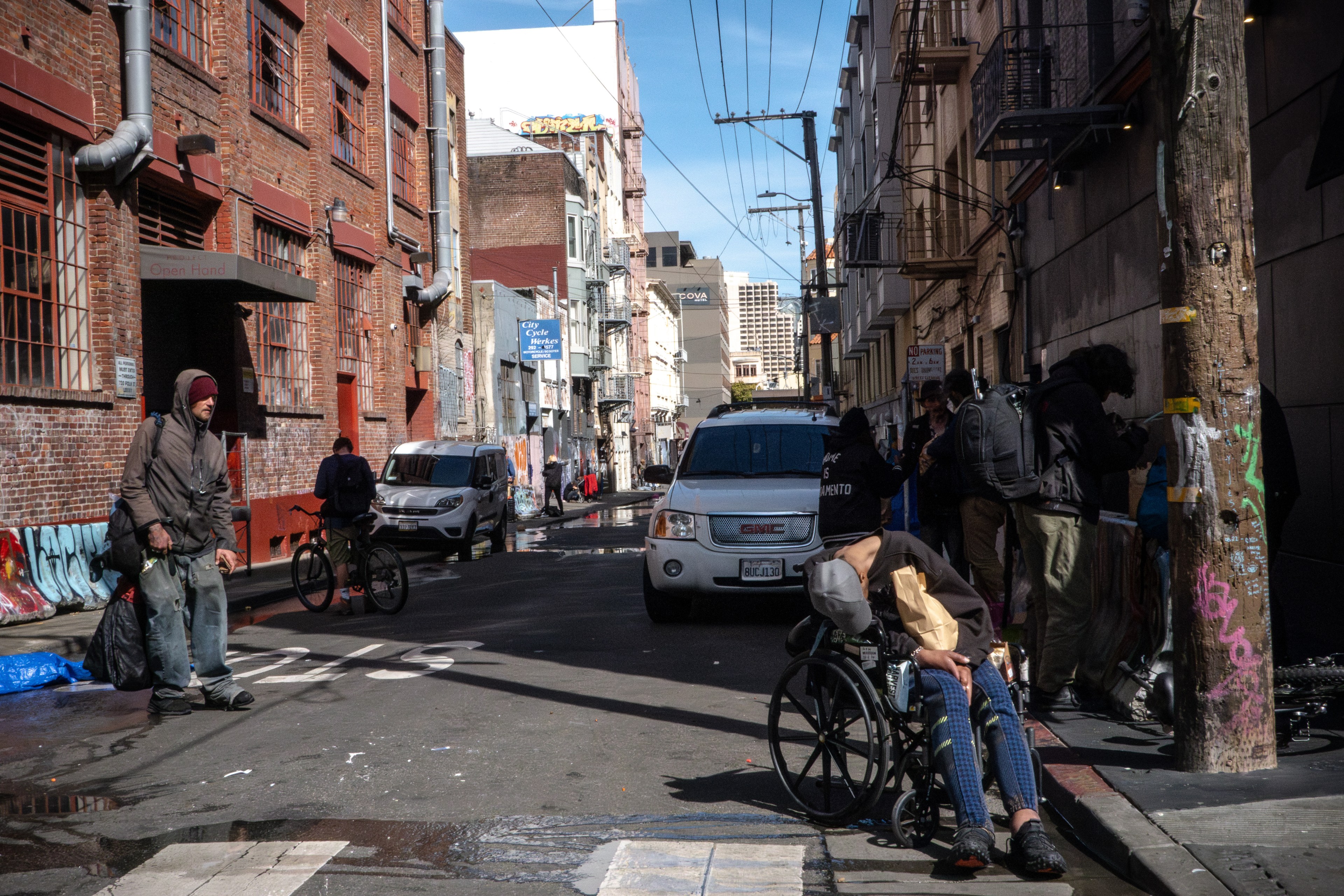Dean Maric, a 28-year-old homeless man, was just waking up from a nap on the corner of Polk and Willow streets at around 3 p.m. on Thursday as he fished for a hit of fentanyl from his pocket. For a pipe, he used a broken pen inscribed with the San Francisco Homeless Outreach Team’s logo.
Maric’s skin was covered in scabs from a skin condition he contracted by sleeping on the sidewalk. He had yanked most of the hair out of his scalp and his feet appeared broken—jutting sideways from the rest of his body.
He nibbled on a melted pack of M&Ms as he explained why so many homeless people live on Willow Street.
“They’re shutting it all down,” he said, explaining how the city had moved him from block to block around the Tenderloin before ending up on Willow.
“But it doesn’t really bother me because I don’t have any items,” he said, wiping dirt off his cheek from sleeping face down on the sidewalk.
Willow Street, where Maric sat, is a longstanding hot spot for homelessness and drug activity in San Francisco.
But even as the city’s leaders tout an improvement in street conditions in its most troubled neighborhood, residents of this beleaguered street say the crackdown has intensified their issues.
People living and working along Willow Street, a strip of alleyways between Van Ness and Larkin streets, say the city’s effort to clean up the rest of the neighborhood has effectively cornered homeless people, drug activity and crime near their homes and businesses.
Housed residents say they fear for their safety. Their complaints about those living on the street below include weapons, fires and prolific drug use. They claim their calls on the city for help are often countered with excuses and in one case—a $560 fine.
Josh Srago, who lives and works in a condo above Willow Street, said he’s disturbed by the constant noise that reverberates through his living room from the alley below.
“When we first moved in, it was like having another neighbor,” Srago said. “Then a different crowd moved in.”
He said the city’s solutions are short-lived and his calls for help are often responded to with excuses, as police blame a court ruling for their inability to address problematic homeless encampments.
Srago said he called the police on a man wielding a machete in February, but officers just spoke to the man and moved on. Police were contacted for details on the incident but did not respond by publication time.
A common refrain from the police department, Srago said, is that his block of Willow Street lies just outside of the Tenderloin station’s purview—meaning there are fewer resources allocated for issues related to homelessness.
“If this is our life, so be it,” Srago said, noting he doesn’t necessarily blame the police. “We just want transparency.”
The Department of Emergency Management and the San Francisco Police Department both denied this claim, contending the city’s police stations work in unison.
In a statement, the DEM said its outreach workers visit Willow Street more than any other location in the city and the street is cleaned every Tuesday.
The police department said Willow Street suffers from poor street conditions because of its proximity to the city’s drug trade and due to its “privacy from busier streets.”
On Monday night, a Standard reporter witnessed a young woman overdose across from Willow on Larkin Street. She lay on the ground, her face covered in blood, as another homeless woman gave her CPR and administered the overdose reversal drug Narcan.
Just when the crowd of people surrounding her started giving up hope, the woman jolted awake and attempted to run away as an ambulance approached. After nearly breaking free, she crumpled back to the ground and paramedics carried her limp body onto a stretcher.
A few days later, on Thursday, a formerly homeless woman named Tara, who refused to give her last name, was checking on a homeless friend struggling with suicidal thoughts on Willow Street. She explained that many people live on Willow because they’re less likely to be harassed by police than in other places.
She said the city needs more intensive case management to help people out of homelessness and drug addiction.
“Willow’s been like this forever. … It’s close to services and it’s close to the Hondos,” Tara said, referring to Honduran drug dealers. “A lot of people are being harassed and bullied out of these other spots.”
Mustafa Damrawi, owner of Hot Zone clothing store on Polk Street, said he blames the street conditions for his failing business. His store, which sells women’s clothing, lingerie, wigs and sex toys, made just $54 last week, he said.
After Damrawi reported a fire just outside his storefront in December, the fire department sent him a medical bill for $560, marking the last time he would ever call the city for help, he said.
Once The Standard inquired about the incident, fire officials said the fine was a mistake that it was working to resolve.
“For me, I lost my business,” Damrawi said. “There’s nothing I can do.”
